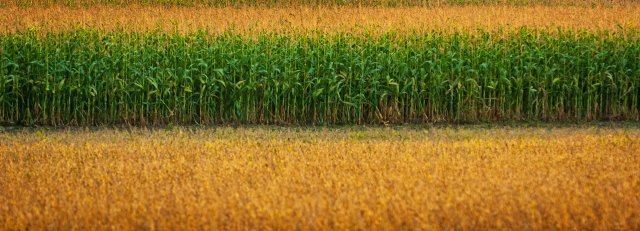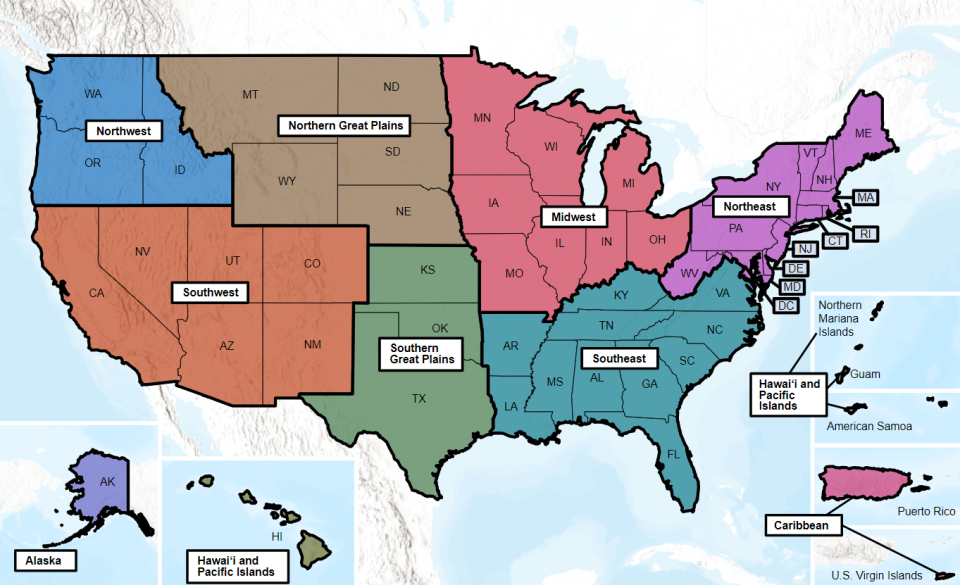Climate Change Connections: Iowa (Corn)
Climate change is impacting all regions and sectors of the United States. The State and Regional Climate Change Connections resource highlights climate change connections to culturally, ecologically, or economically important features of each state and territory. The content on this page provides an illustrative example. As climate change will affect each state and territory in diverse ways, this resource only describes a small portion of these risks. For more comprehensive information about regional climate impacts, please visit the Fifth National Climate Assessment and Climate Change Impacts by Sector.
On this page:
Introduction: Corn Stands Tall in Iowa’s Economy

Known for its prolific crop production, Iowa sits at the heart of America’s breadbasket and Corn Belt. Iowa is the top producer of corn, hogs, and chicken eggs in the United States, and is the nation’s second-largest producer of soybeans.1 Agriculture plays a major role in the state economy, supporting thousands of jobs.2 Corn production generated over $12 billion for Iowa’s economy in 2023.3
Fertile soils, relatively flat terrain, ample rainfall, and sunlight have helped make the region agriculturally productive.4 The humidity is high enough to prevent plants from drying out, but low enough to not consistently cause fungus and mold growth. Rain is abundant enough to recharge water reservoirs, but not so intense that it prevents spring planting due to waterlogged soils. Iowa also receives plenty of sunlight and high summer temperatures; corn thrives in this environment. In addition to deep soils and sufficient rainfall, Iowa provides a long, warm growing season for corn to flourish.
Climate Impacts: Warming Temperatures Are Expected to Affect Corn Growing Season and Productivity
Changes in precipitation and rising extreme temperatures are expected to reduce agricultural productivity.5 Temperatures are projected to increase more in the Midwest, placing further stress on the region.5 While some impacts of climate change could be beneficial to some crops in the Midwest over the short term, projected moisture and temperature changes are expected to negatively affect crop production. With increasing temperatures, corn and soybean productivity is projected to decline further by the end of the century. In addition, higher temperatures can make it harder for corn to retain water, further limiting crop yields.5
Warming temperatures can promote pests such as corn earworm to expand into northern parts of the Midwest.5 Warming winters have already made it easier for existing pests to survive, and are enabling new insect pests and crop pathogens to expand their ranges northward.5 In addition, higher temperatures can lead to increased weed growth, resulting in lower crop yields due to greater competition for nutrients and water.5

Precipitation Changes Affecting Soil and Crops
Climate change is contributing to an increase in heavy precipitation events.6 As average temperatures at the Earth’s surface rise, more evaporation and transpiration occur, adding more moisture to the air, which in turn increases overall precipitation. In recent decades, more rainfall has been occurring as intense single-day rainfall events.7 Heavy precipitation events can contribute to soil erosion and undermine soil health.6 Flooding can also disrupt planting schedules. In addition to more heavy precipitation events, Iowa has experienced overall increasing spring precipitation trends, with rates above average since 1990.8 Corn planting in parts of the Midwest has been delayed by almost a month due to excessive spring moisture.5
Even as increased precipitation events are projected, the incidence of droughts in the Midwest is also expected to increase.5 Rising temperatures are expected to increase evaporation rates, making the soil unable to hold moisture for as long after rainfall. Droughts and excessive moisture issues have contributed to decreased corn yields of nearly 37 percent in some parts in the Midwest.5 More intense droughts are expected to increasingly threaten crops and may increase demands for irrigation. The combined impacts of warming temperatures, changing precipitation patterns, and rapid transitions between extreme wet and dry conditions are expected to have broad consequences for agriculture, local economies, and food security in the Midwest.5
Taking Action: Preparing Agriculture for Changing Conditions
Addressing climate change requires reducing greenhouse gas emissions while preparing for and protecting against current and future climate impacts. Communities, public officials, and individuals in every part of the United States can continue to explore and implement climate adaptation and mitigation measures. In Iowa, farmers continue to take steps to improve resiliency and implement adaptation measures, tailored to local needs, including:
- Selecting heat-, drought-, and pest-tolerant corn varieties. Farmers, researchers, and agencies are collaborating to identify and implement heat-, drought-, and pest-resistant varieties of corn that can grow better in warming conditions. The U.S. Department of Agriculture (USDA) Midwest Climate Hub offers insights and information for selecting crop varieties and other agricultural adaptation strategies in Iowa and the Midwest.
- Promoting healthy soils. Promoting healthy soils can help agriculture become more resilient in a changing climate. Many farmers are responding to climate change by using conservation practices and leveraging no-till farming, a technique that minimizes disruptions to the soil and helps prevent erosion.9 Plant cover also helps preserve soil health and stores carbon. Many farmers increasingly use cover crops, which can also help prevent erosion and have many other benefits in Iowa and across the Midwest.10
To learn more about climate change impacts in Iowa and the Midwest region, see Chapter 24 of the Fifth National Climate Assessment.
Related Resources
- EPA Climate Change Indicators: Heavy Precipitation
- EPA Climate Change Indicators: Length of Growing Season
- Iowa State Climate Summary 2022 (NOAA)
- Fifth National Climate Assessment: Agriculture, Food Systems, and Rural Communities
- Climate-Smart Agriculture and Forestry (USDA)
- Adaptation Resources for Agriculture: Responding to Climate Variability and Change in the Midwest and Northeast (USDA) (pdf) (1.3 MB)
- Midwest U.S. Climate Resiliency Toolkit (USDA)
- Midwest Climate Hub (USDA)
References
1 Economic Research Service. (2023). Cash receipts by commodity, state ranking, 2022. U.S. Department of Agriculture. Retrieved January 15, 2024, from https://data.ers.usda.gov/reports.aspx?ID=17844
2 Iowa Workforce Development. (2022). 2022 Iowa industry profile: Agriculture, forestry, fishing & hunting. https://workforce.iowa.gov/media/747/download?inline=
3 U.S. Department of Agriculture National Agricultural Statistics Service. (2024). 2023 State agriculture overview: Iowa. Retrieved January 23, 2024, from https://www.nass.usda.gov/Quick_Stats/Ag_Overview/stateOverview.php?state=IOWA
4 U.S. Geological Survey. (1999).Geology of the Loess Hills, Iowa. Retrieved January 15, 2024, from https://pubs.usgs.gov/info/loess/
5 Wilson, A. B., Baker, J. M., Ainsworth, E. A., Andresen, J., Austin, J. A., Dukes, J. S., Gibbons, E., Hoppe, B. O., LeDee, O. E., Noel, J., Roop, H. A., Smith, S. A., Todey, D. P., Wolf, R., & Wood, J. D. (2023). Ch. 24. Midwest. In A. R. Crimmins, C. W. Avery, D. R. Easterling, K. E. Kunkel, B. C. Stewart, & T. K. Maycock (Eds.), Fifth National Climate Assessment. U.S. Global Change Research Program. https://doi.org/10.7930/NCA5.2023.CH24
6 EPA. (2021). Climate change indicators: Heavy precipitation [Reports and Assessments]. Retrieved December 29, 2023, from https://www.epa.gov/climate-indicators/climate-change-indicators-heavy-precipitation
7 Marvel, K., Su, W., Delgado, R., Aarons, S., Chatterjee, A., Garcia, M. E., Hausfather, Z., Hayhoe, K., Hence, D. A., Jewett, E. B., Robel, A., Singh, D., Tripati, A., & Vose, R. S. (2023). Ch. 2. Climate trends. In A. R. Crimmins, C. W. Avery, D. R. Easterling, K. E. Kunkel, B. C. Stewart, & T. K. Maycock (Eds.), Fifth National Climate Assessment. U.S. Global Change Research Program. https://doi.org/10.7930/NCA5.2023.CH2
8 Frankson, R., Kunkel, K. E., Champion, S. M., & Runkle, J. (2022). Iowa state climate summary 2022 (NOAA Technical Report NESDIS 150-IA). NOAA National Environmental Satellite, Data, and Information Service. https://statesummaries.ncics.org/chapter/ia/
9 Arbuckle, J.G., Jr. (2021, January 22). Iowa farm and rural life poll shows farmers’ beliefs on climate change are shifting. Iowa State University Extension and Outreach | News. Retrieved January 15, 2024, from https://www.extension.iastate.edu/news/iowa-farm-and-rural-life-poll-shows-farmers-beliefs-climate-change-are-shifting
10 U.S. Department of Agriculture. (n.d.). Cover crops and crop rotation. Retrieved January 15, 2024, from https://www.usda.gov/peoples-garden/soil-health/cover-crops-crop-rotation

